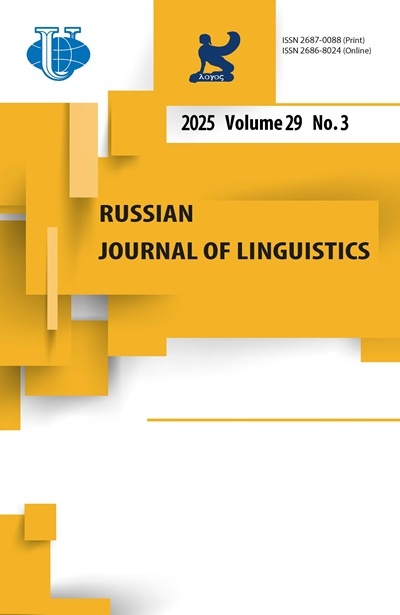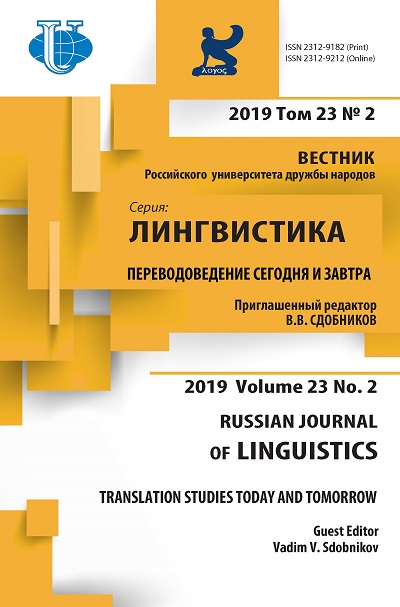Переводоведение сегодня: вечные проблемы и новые вызовы
- Авторы: Сдобников В.В.1
-
Учреждения:
- Нижегородский государственный лингвистический университет им. Н.А. Добролюбова
- Выпуск: Том 23, № 2 (2019): Переводоведение сегодня и завтра
- Страницы: 295-327
- Раздел: ПЕРЕВОДОВЕДЕНИЕ СЕГОДНЯ И ЗАВТРА
- URL: https://journals.rudn.ru/linguistics/article/view/21209
- DOI: https://doi.org/10.22363/2312-9182-2019-23-2-295-327
- ID: 21209
Цитировать
Полный текст
Аннотация
В данной статье представлен обзор основных тенденций в современном переводоведении, предпринятый на основе изучения наиболее значимых работ, созданных в разных областях науки о переводе. Обзор свидетельствует о том, что не только проблематика переводоведения стала более разнообразной, что связано с определенными изменениями в характере самой переводческой деятельности, но и само переводоведение приобрело междисциплинарный характер, вовлекло данные смежных дисциплин. В рамках переводоведения произошли определенные «повороты» и возникли новые парадигмы исследования перевода. К числу наиболее важных явлений в области переводоведения относятся «культурный поворот», а также «поворот», который можно назвать антропоцентрическим, послуживший основанием для развития коммуникативно-функционального подхода к осуществлению и изучению перевода. Он предполагает «погружение» переводчика в коммуникативную ситуацию, в которой осуществляется перевод, ее анализ с целью уяснения цели перевода. Данный подход позволяет более точно сформулировать задачи, решаемые переводчиками в рамках осуществления как традиционных видов перевода (художественный перевод, религиозный перевод, устный перевод), так и относительно новых видов переводческой деятельности (аудиовизуальный перевод, локализация). В статье обосновывается утверждение, что собственно перевод является главным элементом любой деятельности, осуществляемой переводчиком, и всякая переводческая деятельность предполагает культурную адаптацию текста к восприятию получателей перевода. Основная особенность переводоведения сегодня - его ориентированность на практику, на изучение закономерностей переводческой деятельности, что дает возможность постижения как особенностей различных видов перевода, так и сути перевода как вида человеческой деятельности.
Об авторах
Вадим Витальевич Сдобников
Нижегородский государственный лингвистический университет им. Н.А. Добролюбова
Email: artist232@rambler.ru
доктор филологических наук, заведующий кафедрой теории и практики английского языка и перевода Нижегородского государственного лингвистического университета им. Н.А. Добролюбова, председатель Правления Союза переводчиков России ул. Минина, 31-А, Нижний Новгород, 603155, Россия
Список литературы
- Bassnett, Susan (2005). Translation Studies. 3rd ed. London and New York, Routledge.
- Bassnett, Susan / Lefevere, André (1998). Constructing Cultures. Essays on literary translation. Clevendon-Philaselphia: Multilingual Matters (Topics in translation 11).
- Chaume, Frederic (2016). Audiovisual translation trends: growing diversity, choice and enhanced localization. Media across borders. Localizing film, TV and video games. Ed. by A. Esser, M.A. Bernal-Merino, I.R. Smith. New York: Routledge, 68-84.
- Cranmer, Robin (2015). Introducing Intercultural Communication into the Teaching of Translation. Russian Journal of Linguistics, 19 (4), 155-174.
- Díaz Cintas, Jorge (2009). Introduction - Audiovisual Translation: An Overview of Its Potential. New Trends in Audiovisual. Ed. by J. Díaz Cintas. Bristol; Buffalo; Toronto, 1-18.
- Fridge. Available at: http://fridge.com.ua/2011/02/lokalizatsiya-perevoda/.
- Gambier, Yves (2008). Recent developments and challenges in audiovisual translation research. Between Text and Image: Updating Research in Screen Translation. Amsterdam; Philadelphia: John Benjamins Publ. Co., 11-35.
- Gambier, Yves (2016б). Rapid and Radical Changes in Translation and Translation Studies. International Journal of Communication. Issue 10, 887-906.
- Gentzler, Edwin (1990). Contemporary Translation Theory: Dissertation submitted for the degree of Doctor of Philosophy in Comparative Literature. Nashville, Tennessee.
- Gentzler, Edwin (2001). Contemporary Translation Theories. Revised 2nd Edition. Clevedon, Multilingual Matters Ltd.
- Gottlieb, Henrik (2009). Subtitling against the Current: Danish concepts, English minds. J. Díaz Cintas (Ed.). New Trends in Audiovisual Translation. Bristil; Buffalo; Totonto, 21-43.
- Hatim, Basil / Mason, Ian (2005). The Translator as Communicator. London, New York: Routledge.
- Jacobson, Roman (1959). On Linguistic Aspects of Translation. On Translation. Harvard University Press, Cambridge, Massachusetts.
- Jäger, Gert (1975). Translation und Translationslinguistik. Halle (Saale): VEB Max Niemeyer.
- Kade, Otto (1981). Probleme des übersetzungswissenschaftlichen Textvergleichs. Leipzig: VEB Enzyklopädie (Übersetzungswissenschaftliche Beiträge 4).
- Katan, David. Translation as Intercultural Communication. The Routledge Companion to Translation Studies. Revised edition. Ed. by Jeremy Munday. London, New York: Routledge.
- Koskinen, Kaisa (2015). Training Translators for a Superdiverse World. Translators’ Intercultural Competence and Translation as Affective Work. Russian Journal of Linguistics, 19 (4), 175-184.
- Larson, Mildred (1974). The communicative situation and rhetorical questions. Notes on Linguistics, 9, 14-18.
- LISA. The Localization Industry Primer. 2nd ed. Available at: https://www.immagic.com/eLibrary/ ARCHIVES/GENERAL/LISA/L030625P.pdf
- Moser-Mercer, Barbara (1978). Simultaneous Interpretation: A Theoretical Model and its Practical Application. Gerver, D. et Sinaiko, W.H. Language, Interpretation and Communication. New York, Plenum Press, 353-368.
- Moser-Mercer, Barbara, Künzli, Alexander, Korac, Marina (1998). Prolonged turns in interpreting: Effects on quality, physiological and psychological stress. Interpreting, No. 3 (1), 47-64.
- Neubert, Albrecht (1973). Theorie und Praxis für die Übersetzungswissenschaft. Linguistische Arbeitsberichte 7, 120-144.
- Nida, Eugene (1964). Toward a Science of Translating. With Special Reference to Principles and Procedures in Bible Translating. Leiden: Brill.
- Nida, Eugene / Taber, Charles (1969). The Theory and Practice of Translation. Leiden: Brill.
- Nida, Eugene (1993). Language, Culture and Translating. Shanghai: Foreign Language Education Press.
- Nida, Eugene (1996). The Sociolinguistics of Interlingual Communication. Bruxelles: Éditions du Hazard (collection Traductologie).
- Nord, Christiane (2005). Text Analysis in Translation. Theory, Methodology and Didactic Application of a Model of Translation-Oriented Text Analysis. 2nd ed. Editions Rodopi, Amsterdam - New York.
- Pettit, Zoë (2009). Connecting cultures: cultural transfer in subtitling and dubbing. J. Díaz Cintas (Ed.). New Trends in Audiovisual Translation. Bristil; Buffalo; Totonto, 44-57.
- Prunč, Erich (2007). Entwicklungslinien der Translationswissenschaft. Von den Asymmetrien der Sprachen zu den Asymmetrien der Macht. Frank & Timme GmbH.
- Pym, Anthony (2009). Natural and directional equivalence in theories of translation. The metalanguage of translation. Eds. Y. Gambier, L. van Doorslaer. Amsterdam, Philadelphia, John Benjamins Publ.
- Pym, Anthony (2011). What Technology Does to Translating. Translation and Interpreting. Vol. 3. 1(2011). Available at: https://cloud.mail.ru/public/4QBA/ZuUpBXypn/PYM.What technologies does to translating.pdf
- Reiss, Katharina / Vermeer, Hans J. (1984): Allgemeine Grundlegung einer Translations theorie. Tübingen: Niemeyer.
- Reiß, Katharina / Vermeer, Hans (2013). Towards a General Theory of Translational Action. Skopos Theory Explained / Translated from German by Christiane Nord. Manchester: St. Jerome Publishing.
- Sdobnikov, Vadim (2011). Translation Strategy Revised: The Communicative-Functional Approach. Journal of Siberian Federal University. Humanities & Social Sciences. V. 4 (10).
- Sdobnikov, Vadim (2017). Communicative-Functional Approach in Russian Translation Studies: Where Does It Come From? Science Journal of VolSU. Linguistics. 2017. Vol. 16. No. 3.
- Snell-Hornby, Mary (2006). The Turns of Translation Studies. New Paradigms or Shifting Viewpoints? Amsterdam/Philadelphia: John Benjamins.
- Toury, Gideon (1995). Descriptive Translation Studies and beyond. Amsterdam/Philadelphia: Benjamins (Benjamins Translation Library 4).
- Wilss, Wolfram. (1982). The Science of Translation: Problems and Method. Tubingen: Narr.
- Гамбье И. Перевод и переводоведение на перекрестке цифровых технологий // Вестник СПбГУ. Серия 9. 2016. Вып. 4 [Gambier, Ives (2016). Perevod i perevodovedenie na perekrestke tsifrovykh tekhnologii (Translation and Translation Studies at the Crossroads of Digital Communications). Vestnik SPbGU. Ser. 9. Vyp. 4 (In Russ.)].
- Гарбовский Н.К. Отражение как свойство перевода. Вестник МГУ. Серия 22. Теория перевода. 2008. № 4. С. 26-36. [Garbovskiy, N.K. (2008). Otrazhenie kak cvoictvo perevoda (Reflection as a Property of Translation). Vestnik MGU. Ser. 22. Teorija perevoda. № 4. 26-36. (In Russ.)].
- Горшкова В.Е. Перевод в кино: монография. Иркутск: ФГБОУ ВПО «ИГЛУ», 2006 [Gorshkova, V.E. (2006). Perevod v kino: monografija (Film Translation: monograph). IGLU (In Russ.)].
- Горшкова В.Е. Перевод кинодиалога как осмысленный произвол // Перевод: ремесло, искусство, наука: монография / Под общ. ред. В.Е. Горшковой. Иркутск: Изд-во ИГУ, 2017 [Gorshkova, V.E. (2017). Perevod kinodialoga kak osmyslenny proizvol (Translation of Film Dialogue as a Conscious Abuse). Perevod: remeslo, iskusstvo, nauka: monografija. Irkutsk, IGU (In Russ.)].
- Козуляев А.В. Аудиовизуальный полисемантический перевод как особая форма переводческой деятельности и особенности обучения данному виду перевода. XVII Царскосельские чтения: мат-лы Междунар. науч. конф-ции, 23-24 апреля 2013 г. СПб., 2013. Т. I [Kozulyaev, A.V. (2013). Audiovizualny polisemantichesky perevod kak osobaja forma perevodcheskoi deyatelnosti I osobennosti obuchenija dannomu vidu perevoda (Audiovisual Polysemantic translation as a specific form of translation activity and methods of teaching it). XVII Tsarskoselskie chtenija: materialy mezhdunarodnoi nauchnoi konferentsii, 23-24 aprelya 2013 goda. Saint-Petersburg (In Russ.)].
- Комиссаров В.Н. Теория перевода (лингвистические аспекты). М.: Высшая школа, 1990. [Komissarov, V.N. (1990). Teorija perevoda (Lingvisticheskie aspekty) (Translation Theory (Linguistic Aspects). Moscow, Vysshaja Shkola Publishing House (In Russ.)].
- Ларин Б.А. Наши задачи. Теория и критика перевода. Л., 1962 [Larin, B.А. (1962). Nashi zadachi (Our Tasks). Teorija i kritika perevoda. Leningrad (In Russ.)].
- Львовская З.Д. Теоретические проблемы перевода (на материале испанского языка). М.: Высшая школа, 1985 [Lvovskaya, Zinaida (1985). Teoreticheskie problem perevoda (na materiale ispanskogo jazyka) (Theoretical Problems of Translation (on the material of Spanish). Moscow, Vysshaya shkola (In Russ.)].
- Львовская З.Д. Современные проблемы перевода: Пер. с исп. М.: Издательство ЛКИ, 2008 [Lvovskaya, Zinaida (2008). Sovremennye problemy perevoda (Modern Problems of Translation). Moscow, LKI Publishing House (In Russ.)].
- Малёнова Е.Д. Теория и практики аудиовизуального перевода: отечественный и зарубежный опыт. Коммуникативные исследования, 2017, № 2(12), 32-46 [Malyonova, E.D. (2017). Teorija i prektika audiovizualnogo perevods: otechestvenny i zarubezhny opyt (Theory and Practice of Audiovisual Translation: Russian and Foreign Experience). Kommunikativnye issledovanija, 2017, No 2(12) (In Russ.)].
- Матасов Р.А. Перевод кино/видео материалов: лингвокультурологические и дидактические аспекты: дис. … канд. филол. наук. М., 2009 [Matasov, R.A. (2009). Perevod kino/video materialov: lingvokulturologicheskie i didakticheskie aspekty (Translation of Films and Videos: Linguocultural and Didactic Aspects): diss…kand. filol. nauk. Moscow (In Russ.)].
- Миньяр-Белоручев Р.К. Последовательный перевод. Теория и методика обучения. М.: Воениздат, 1969 [Minjar-Beloruchev, R.K. (1969). Posledovatelnyi perevod. Teotija i metodika obuchenija (Consecutive Interpreting. Theory and Methods of Teaching). Moscow, Voenizdat (In Russ.)].
- Миньяр-Белоручев Р.К. Общая теория перевода и устный перевод. М.: Воениздат, 1980 [Minjar-Beloruchev, R.K. (1980). Obshchaja teorija peredoda i ustnyi perevod (General Translation Theory and Oral Interpreting). Moscow, Voenizdat (In Russ.)].
- Прунч Э. Пути развития западного переводоведения. От языковой асимметрии к политической. М.: Р.Валент, 2015 [Prunč, Erich (2015). Puti razvitija zapadnogo perevodovedenija. Ot jazykovoi asimmetrii k politicheskoi (Ways of Development of Western Translation Studies. From Language Asymmetry to Political One). Moscow, R.Valent (In Russ.)].
- Сдобников В.В., Петрова О.В. Теория перевода: учебник для студентов лингвистических вузов и факультетов иностранных языков. М.: АСТ: Восток-Запад, 2006 [Sdobnikov, Vadim, Petrova, Olga (2006). Teorija perevoda (Translation Theory). Moscow, AST; Vostok-Zapad (In Russ.)].
- Сдобников В.В. Перевод и коммуникативная ситуация: монография. М.: Флинта: Наука, 2015 [Sdobnikov, Vadim (2015). Perevod i kommunikativnaja situatsija (Translation and Communicative Situation: monograph). Moscow, Flinta: Nauka (In Russ.)].
- Федоров А.В. Основы общей теории перевода. 4-е изд. М.: Высшая школа, 1983 [Fedorov, Andrei (1983). Osnovy obshchei teorii perevoda (Fundamentals of General Translation Theory). 4th ed. Moscow, Vysshaya shkola (In Russ.)].
- Чернов Г.В. Основы синхронного перевода. М.: Высшая школа, 1987 [Chernov, G. (1987). Osnovy sinkhronnogo perevoda (Fundamentals of Simultaneous Interpreting). Moscow, Vysshaja Shkola (In Russ.)].
- Швейцер А.Д. Теория перевода: статус, проблемы, аспекты. М.: Наука, 1988 [Svejtser, Aleksandr (1988). Teorija perevoda: status, problem, aspekty (Translation Theory: Status, Problems, Aspects). Moscow, Nauka (In Russ.)].
- Ширяев А.Ф. Синхронный перевод: Деятельность синхронного переводчика и методика преподавания синхронного перевода. М.: Воениздат, 1979 [Shiryaev, A.F. (1979). Sinkhronny perevod. Dejatelnost sinkhronnogo perevodchika i metodika prepodavanija sinkhronnogo perevoda (Simultaneous Interpreting: Simultaneous Interpreter’s Activity and Methods of Teaching Simultaneous Interpreting). Moscow, Voenizdat (In Russ.)].
- Якобсон Р.О. Лингвистика и поэтика // Структурализм: «за» и «против»: Сборник научных статей. М.: Прогресс, 1975. С. 193-230. [Jacobson, R.O. (1975). Lingvistika i poetika (Linguistics and Poetics). Strukturalizm: za i protiv. Moscow, Progress Publishing House. P. 193-230. (In Russ.).].
Дополнительные файлы















